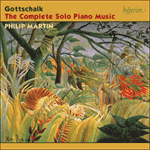
Welcome to Hyperion Records, a British classical label devoted to presenting high-quality recordings of music of all styles and from all periods from the twelfth century to the twenty-first.
Hyperion offers both CDs, and downloads in a number of formats. The site is also available in several languages.
Please use the dropdown buttons to set your preferred options, or use the checkbox to accept the defaults.

It was not written, as might be thought, to herald a trip to Britain—Gottschalk never made it across the Channel—but for one of a series of concerts in Geneva in the autumn of 1850. The tune, at that time, served for the Swiss national anthem as it did for at least seven of the states of Germany and several Scandinavian countries.
The music bears witness to the fact that the Swiss premiere was not the same as the final printed version: ‘Paris 1852–Havana 1860’ stands at the top of the score. In the United States, the tune had acquired many sets of words (‘God save America’, ‘God save George Washington’ and others) and is known today as ‘America’. The present American words, ‘My country, ’tis of thee’ date from 1831. All in all, Gottschalk’s morceau de concert proved a useful travelling companion. The final American version was dedicated to the great Russian pianist Anton Rubinstein. Did the two ever meet? It seems unlikely. Rubinstein did not visit America until 1872, by which time Gottschalk had been dead for three years.
from notes by Jeremy Nicholas © 2004
Cette œuvre n’a pas été écrite, comme on pourrait le supposer, pour célébrer un voyage en Grande-Bretagne—jamais Gottschalk ne traversa la Manche—mais pour une série de concerts qui se tenait à Genève à l’automne 1850. La mélodie, à l’époque, servait aussi d’hymne national suisse, tout comme elle le faisait pour au moins sept États d’Allemagne et de plusieurs pays scandinaves.
La musique témoigne du fait que la première donnée en Suisse diffère de la partition finalement publiée: «Paris 1852–Havane 1860» figure en tête de la partition. Aux Etats-Unis, la mélodie avait acquis des textes différents («God save America», «God save George Washington» et autres). Elle est maintenant connue comme «America». Les mots actuels américains, «My country, ’tis of thee» datent de 1831. Quoi qu’il en soit, le morceau de concert de Gottschalk se trouve être un compagnon de voyage utile. La version finale américaine fut dédiée au grand pianiste russe, Anton Rubinstein. Les deux se sont-ils rencontrés? Cela semble peu probable. Rubinstein ne se rendit en Amérique qu’en 1872, alors que Gottschalk était enterré depuis trois ans déjà.
extrait des notes rédigées par Jeremy Nicholas © 2004
Français: Isabelle Battioni
Dieses Stück entstand nicht, wie man annehmen könnte, um einen Aufenthalt in Großbritannien anzukündigen—Gottschalk hat es nie geschafft, den Ärmelkanal zu überqueren—sondern für eine Konzertreihe in Genf, die im Herbst 1850 stattfand. Die Melodie diente zu jener Zeit als schweizerische Nationalhymne und auch als Hymne von mindestens sieben deutschen sowie mehreren skandinavischen Ländern.
Der Notentext legt Zeugnis darüber ab, dass die Schweizer Premiere mit der endgültigen Druckfassung nicht übereinstimmte: „Paris 1852—Havanna 1860“ steht auf der Partitur geschrieben. In den Vereinigten Staaten hat die Melodie diverse Texte angenommen („God save America“, „God save George Washington“ und andere) und ist heute als „America“ bekannt. Der heutige amerikanische Text, „My country, ’tis of thee“ stammt aus dem Jahre 1831. Insgesamt gesehen entpuppte sich Gottschalks morceau de concert als ein geeignetes Werk für Konzertreisen. Die endgültige amerikanische Version ist dem großen russischen Pianisten Anton Rubinstein gewidmet. Haben sich die beiden je kennengelernt? Wahrscheinlich ist es nicht. Rubinstein reiste 1872 zum ersten Mal nach Amerika und zu dem Zeitpunkt war Gottschalk schon drei Jahre tot.
aus dem Begleittext von Jeremy Nicholas © 2004
Deutsch: Viola Scheffel
 Gottschalk: The Complete Solo Piano Music Gottschalk: The Complete Solo Piano MusicWith his idiomatic and graceful style, pianist Philip Martin has established himself as the foremost exponent of Gottschalk. The composer had a unique spontaneity and individuality which Martin’s performances bring vividly to the fore. The complet ...» More |

